 December 1, 2016 John E. Ross, KD8IDJ, Editor
| ||||||
ARRL Issues Urgent Last Call to Press for Senate Passage of Amateur Radio Parity Act It's now down to the wire: ARRL has issued a last call for members to urge their US Senators to support the Amateur Radio Parity Act (H.R. 1301) when it comes up during the "lame duck" session of Congress that adjourns in a couple of weeks. The House of Representatives approved the bill in September, and the Senate must follow suit if the bill is to succeed. If it fails in the Senate, the entire process will have to be repeated in the new Congress. The legislation is now in the Senate in two forms -- as H.R. 1301 and alternately in the packaged bill S. 253.
ARRL Hudson Division Director Mike Lisenco, N2YBB, who chairs the ARRL Board's Legislative Advocacy Committee and has been heavily involved in efforts to move H.R. 1301 forward, echoed President Roderick's sentiments. He said the bill was just starting to build momentum in the Senate following its unanimous passage in the House, when Congress shut down for the 4 weeks prior to Election Day. He pointed out that H.R. 1301 has received broad support from both parties.
Urging your US Senators' support is simple: Go to our Rally Congress page, enter your ZIP code, fill in your name and address, press enter, and e-mails will go directly to your Senators. Members may do this even if they have already contacted their US Senators for support. There are no guarantees, Lisenco has pointed out. "In order to have a chance at overcoming political obstacles that have little or nothing to do with the legislation, we need our voices to be heard," he said. "And we need that input today!" President Roderick urged members to "reach out one more time to your Senators today! Right away. Right now!" Read more. Transatlantic Reception Anniversary Special Event Set for December 11 An Amateur Radio special event on December 11 will commemorate the 95th anniversary of the first transatlantic shortwave reception between Greenwich, Connecticut, and Scotland. A school near the original site is hosting the event. ARRL, the Radio Society of Great Britain (RSGB), and the Radio Club of America (RCA), are partnering in sponsoring the activity. The Greenwich Historical Society will also participate.
The N1BCG special event will begin on Sunday, December 11, at 1200 and conclude at 0300 UTC on December 12. It will include an attempt at a two-way contact between N1BCG and GB2ZE, operated by Jason O'Neill, GM7VSB, in Ardrossan.
Reception in Scotland of the 1BCG signal was part of the second series of ARRL transatlantic tests. For the receiving end, the ARRL Board had selected a receiver designed by Paul Godley, 2ZE, and Godley traveled to the UK to oversee that end of the circuit. Joining Godley in a field in Ardrossan, southwest of Glasgow, was Marconi Company District Inspector D.E. Pearson. As the QST article, "The Transatlantic Tests" (QST Dec. 2014) by Michael Marinaro, WN1M, recounted, "The two attempted to keep out of the driving wind and rain by sheltering themselves -- and their equipment -- in a tent. This rough listening post was comprised of a (superheterodyne and regenerative) receiver, a 1,300-foot Beverage antenna suspended 12 feet above ground, batteries, and auxiliary equipment."
On the morning of December 10, CW signals of 1BCG, which had been designed and constructed by Radio Club of America members -- were solidly copied on 230 to 235 meters (about 1.3 MHz). They were the only signals heard that morning in Ardrossan. By the end of the test, eight spark and 18 CW stations had been heard as well. N1BCG operation will be on AM on 75 and 40 meters; CW and SSB on 40 meters, CW on 30 meters, and CW and SSB on 20 and 17 meters. Approximate frequencies are 3.880 (AM), 7.290 (AM), 7.235 (SSB), 7040 (CW), 10.112 (CW), 14.280 (SSB), 14.040 (CW), 18.125 (SSB), and 18.088 MHz CW. Amateur Radio Volunteers Provide Shelter Communication Support in Tennessee Amateur Radio volunteers this week provided communication support to American Red Cross shelters in Sevier County, Tennessee, where area residents fleeing wildfires took refuge. At the peak, an estimated 1,300 evacuees occupied six Red Cross or independently operated shelters, state authorities said. Wind-driven flames and embers from the Chimney Top Fire in Great Smoky Mountains National Park, now closed, spread on November 28 to threaten the communities of Gatlinburg and Pigeon Forge in East Tennessee. Highway 441 into Gatlinburg remains open only to emergency traffic and outbound evacuation traffic. The fire caused considerable destruction in Gatlinburg.
Miller said no amateurs had been requested to support fire teams, law enforcement, EMS, or the Tennessee Emergency Management Agency (TEMA). "Unless conditions begin to deteriorate, we expect not to be asked to fully activate but rather continue to monitor the situation and be ready to support when and if asked to do so," Miller said. "Do not self-deploy," he stressed. "If you show up uninvited, you will be sent home."
In Pigeon Forge -- home to the Dollywood theme park -- officials estimate that 500 residents and visitors were evacuated on Monday. "State agencies and local officials likely evacuated thousands of residents and visitors from Sevier County [Tuesday] night, due to devastating wildfires in and around the cities of Gatlinburg and Pigeon Forge," TEMA estimated on November 29. "It is very likely that 14,000+ residents and visitors evacuated from Gatlinburg alone." The Doctor Will See You Now! "Yagi Antennas" is the topic of the latest (December 1) episode of the "ARRL The Doctor is In" podcast. Listen...and learn!
Every 2 weeks, your host, QST Editor in Chief Steve Ford, WB8IMY, and the Doctor himself, Joel Hallas, W1ZR, will discuss a broad range of technical topics. You can also e-mail your questions to doctor@arrl.org, and the Doctor may answer them in a future podcast. Enjoy "ARRL The Doctor is In" on Apple iTunes, or by using your iPhone or iPad podcast app (just search for "ARRL The Doctor is In"). You can also listen online at Blubrry, or at Stitcher (free registration required, or browse the site as a guest) and through the free Stitcher app for iOS, Kindle, or Android devices. If you've never listened to a podcast before, download our beginner's guide. National Parks on the Air Update ARRL's National Parks on the Air (NPOTA) program is down to its final month. Over 460 of the 489 NPOTA units have been activated, with over 15,500 visits to eligible sites. With 30 days to go, there is a big push to cross the 1 million contact threshold. This past week saw nearly 30,000 contacts uploaded to Logbook of The World, bringing the year-to-date total to more than 915,000 contacts. There will be plenty of NPOTA activity in December; how many stations can you work in the final month?
Keep up with the latest NPOTA news on Facebook. Follow NPOTA on Twitter (@ARRL_NPOTA). ARRL Expands Initiative to Fire Up Collegiate Amateur Radio Clubs A growing number of campus radio clubs and student radio amateurs have begun to share ideas and suggestions on the ARRL Collegiate Amateur Radio Initiative (CARI) Facebook page, which is aimed at sparking renewed participation, activity, and idea-sharing among this special sector of the Amateur Radio community. The now-expanded initiative stemmed from two well-attended ARRL New England Division Convention forums for radio amateurs attending college, one hosted by the Amateur Radio clubs at Harvard (W1AF) and Yale (W1YU). As the forum explained, the activity level at campus Amateur Radio club stations can vary wildly from one year to the next, as students graduate and newcomers arrive.
Gallagher pointed out that "recognized" student activities require students in order to maintain that status. However, even officially recognized college club stations may find themselves at the mercy of administrations in terms of space for a station and antennas, and some clubs have had to move more than once to accommodate their schools' space requirements. Issues involving safety and security can also affect college radio clubs. In a recent post, Kenny Hite, KE8CTL, a graduate teaching assistant at West Virginia University, said the university's Amateur Radio club, W8CUL, has been unable to participate in recent on-the-air events "due to lack of working equipment and questionable antenna setups," as he put it. Another poster, Dennis Silage, K3DS, who's associated with the Temple University Amateur Radio Club (K3TU), said, "A key to a successful and long-running college club seems to be faculty involvement for stability and recognition." He invited other CARI participants to check out the club's website. "It occurred to us that, if college Amateur Radio could galvanize [mutual interests], then colleges might just provide the ideal bridge between youthful interest in the subject and lifelong participation in our community," Gallagher wrote. Read more. FCC Special Counsel Laura Smith Says Amateur Enforcement Will Be Aggressive FCC Special Counsel Laura Smith told a standing-room-only audience at the ARRL Pacific Division Convention (Pacificon) in October that, despite FCC cutbacks, Amateur Radio enforcement will not be compromised. Smith spoke for nearly an hour and a half on a variety of FCC issues related to Amateur Radio, and the entire presentation is available on YouTube, thanks to Bob Miller, WB6KWT, and his son Robert, KA7JKP, who recorded the forum. Smith said that with the FCC set to shut down 11 field offices across the country in January, the Enforcement Bureau has reorganized into three US regions, and she does not anticipate any significant issues for the Amateur Service as a result.
"The amateur community will go forward," she said, noting that amateurs have "an incredible ability to self-police." In light of the field office closings, she has been working with ARRL to revamp the Official Observer (OO) program. "We are going to redo the entire program," she told the Pacificon forum. Given that the field office cutbacks have left the FCC short staffed, the OO program will step into the gap, with OOs serving as the first line of defense in Amateur Radio enforcement, she explained. Working more closely with the OOs, Smith said, will get information on problems to the field staff more quickly, so they can follow up. Smith praised the OOs for contributing their time and effort to monitor the bands and to alert licensees both to problematic and positive behavior on the air. She also said the FCC is more aggressively policing the Amateur Radio bands. HamRadioNow's Gary Pearce, KN4AQ, used Smith's talk as the centerpiece of his episode 281. Read more. Hurricane Watch Net Activates for Hurricane Otto The Hurricane Watch Net (HWN) activated on Thanksgiving Day for Hurricane Otto. The Category 2 storm with maximum sustained winds of 110 MPH made landfall on the southern Nicaraguan coast on November 24 and passed over Central America with no reported fatalities, but it generated flooding. The net stood down at 2200 UTC. Amateur Radio emergency nets also convened in Central America on 40 and 75 meters in anticipation of Tropical Storm Otto, which was the strongest Atlantic hurricane on record this late in the year.
The HWN meets on 14.325 MHz and 7.268 MHz, depending upon conditions. Graves thanked the amateur community for cooperating in keeping those frequencies open. "Your help in keeping the frequency clear allows us to hear those affected by hurricanes," he said. "For instance, when commercial power goes out, some reporting stations have to revert to battery backup and perhaps operate at QRP power, as was the case [on November 24]." Rocky Mountain Division Director Dwayne Allen, WY7FD, Overcomes Challenge to Win Election
ARRL Rocky Mountain Division Director Dwayne Allen, WY7FD, has won election to a 3-year term. As Vice Director, Allen assumed the Director's seat last January, after the Board of Directors elected former Director Brian Mileshosky, N5ZGT, as Second Vice President. Allen outpolled challenger Garth Crowe, WY7GC (ex-N7XKT), 1,112 to 528 votes, to win the seat in his own right. Ballots were counted November 18 at ARRL Headquarters. The Rocky Mountain Division Director's seat was the only contested election for the 2017-2019 cycle. Allen served previously as Wyoming Section Manager, from 2005 until 2007. New terms of office begin on January 1, 2017, at 12 noon Eastern Time. Sign Up for ARRL's 12 Days of Deals!
You'll receive an e-mail a day for 12 days with a special online deal. Each deal is valid for 1 day only at www.arrl.org/shop, and concludes Friday, December 16, 2016. Sign up now and unwrap a new deal every day! SKYWARN Recognition Day On-the-Air Event is Saturday, December 3 The annual SKYWARN Recognition Day (SRD) on-the-air activity will take place Saturday, December 3, from 0000 until 2400 UTC (starts on the evening of Friday, December 2, in US time zones).
The object of the event is for all participating Amateur Radio stations to exchange contact information with as many NWS stations as possible on 80, 40, 20, 15, 10, 6, and 2 meters, plus 70 centimeters. Contacts via repeaters are permitted. Stations will exchange call signs, signal reports, locations, and a one or two-word description of the weather at their respective locations (e.g., "sunny," "rainy," "partly cloudy," "windy"). NWS stations will use various modes, including SSB, FM, AM, RTTY, CW, and PSK31. While using digital modes, special event stations will append "NWS" to their call signs (e.g., N0A/NWS). Event certificates will be electronic and printable from the main website after the conclusion of SRD. An online submission form is available to submit your log summary for SRD. ARRL Seeks Nominations for Six Awards The ARRL is inviting nominations for awards that recognize educational and technological pursuits in Amateur Radio. Nominations are also open for the League's premier award to honor a young licensee.
The ARRL Herb S. Brier Instructor of the Year Award honors an ARRL volunteer Amateur Radio instructor or an ARRL professional classroom teacher who uses creative instructional approaches and reflects the highest values of the Amateur Radio community. The award highlights quality of and commitment to licensing instruction. Nominations are due by March 15, 2017. The ARRL Microwave Development Award pays tribute to a radio amateur or group of radio amateurs who contribute to the development of the Amateur Radio microwave bands. The nomination deadline is March 31, 2017. The ARRL Technical Service Award recognizes a licensed radio amateur or group of radio amateurs who provide Amateur Radio technical assistance or training to others. The nomination deadline is March 31, 2017. The ARRL Technical Innovation Award is granted to a radio amateur or group of radio amateurs who develop and apply new technical ideas or techniques in Amateur Radio. The nomination deadline is March 31, 2017. The Knight Distinguished Service Award was established to recognize exceptionally notable contributions by a Section Manager to the health and vitality of the ARRL. The nomination deadline is April 30, 2017. The ARRL Board of Directors selects all award recipients. Read more. Hamvention® Solicits Nominations for 2017 Awards The 2017 Hamvention® Awards Committee, chaired by Frank J. Beafore, WS8B, has announced that nominations are open for 2017 awards, sometimes considered the Academy Awards of Amateur Radio. The program will bestow awards for Amateur of the Year, Technical Achievement, Special Achievement, and Club of the Year.
Technical Achievement Award: Given to a selected Amateur Radio operator who has achieved technical excellence within the realm of Amateur Radio. Examples are inventions, processes, discoveries, experiments, other technical accomplishments, or any other outstanding technical achievement that contributed to Amateur Radio. Special Achievement Award: Presented to a deserving radio amateur who has made an outstanding contribution to the advancement of the radio art and/or science. This award is usually given to a respected amateur who has spearheaded a single significant project. Amateur of the Year Award: Honors a radio amateur who has made a long-term commitment to the advancement of Amateur Radio. This individual will have a history of contribution to ham radio and will be dedicated to service, professionalism, and the advancement of Amateur Radio avocation. Club of the Year: Recognizes a club that clearly demonstrates its involvement in varied aspects of Amateur Radio for the greater good of their community and/or the nation. Below are links to forms dedicated to the appropriate award nomination. At a minimum, each form should be completed with the information indicated. Please make sure that the nominating person is identified with a method to reach them in the case of questions from the nomination committee. Separate nomination forms are provided for individual awards and for the club award. Submit forms via e-mail to awards@hamvention.org or via USPS to Hamvention Awards Committee, Box 964, Dayton, OH 45401-0964. The nomination period closes on February 1, 2017. Read more. In Brief...
. . . . . .
The K7RA Solar Update Tad Cook, K7RA, Seattle, reports: Average daily sunspot numbers rose from 28.7 to 32.9 over the November 24-30 reporting week. Average daily solar flux rose from 78.5 to 82.6. Geomagnetic indicators rose only slightly, with average planetary A index changing from 12.7 to 13.6, and average mid-latitude A index rising from 10.1 to 10.3.
Predicted planetary A index is 6 on December 1-6; 15, 12, 18, 20, and 10 on December 7-11; 5 on December 12-17; 8, 12, 16, and 22 on December 18-21; 30, 12, and 10 on December 22-24; 8 on December 25-27; 5 on December 28-January 2, and 15, 12, 18, 20, and 10 on January 3-7. Sunspot numbers for November 24 through 30 were 12, 12, 13, 31, 44, 43, and 75, with a mean of 32.9. The 10.7-centimeter flux was 79, 80.9, 81.2, 82.6, 85.2, 85.5, and 83.6, with a mean of 82.6. Estimated planetary A indices were 24, 33, 12, 10, 8, 5, and 3, with a mean of 13.6. Estimated mid-latitude A indices were 17, 24, 9, 9, 7, 4, and 2, with a mean of 10.3. Here is an interesting chart from London's Daily Mail. The blue line is an average of Solar Cycles 1 through 23. The red line is the current cycle 24, and the gray line is Solar Cycle 5, which may be similar to the current cycle. Send me your reports or observations. Just Ahead in Radiosport
Upcoming ARRL Section, State, and Division Conventions
Find conventions and hamfests in your area.
. .
Subscribe to...
Free of charge to ARRL members...
| ||||||
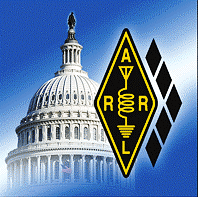 "We are on our final push for the Amateur Radio Parity Act before Congress adjourns," said ARRL President Rick Roderick, K5UR. "The grassroots effort by the Amateur Radio community has been outstanding. Since September, over 110,000 e-mails have been sent to legislators in Congress. Thanks to everyone who has helped, but we can't stop now. Please, keep the e-mails coming and also work the phones down the stretch. Call your Senators! We are almost there. Let's get it done!"
"We are on our final push for the Amateur Radio Parity Act before Congress adjourns," said ARRL President Rick Roderick, K5UR. "The grassroots effort by the Amateur Radio community has been outstanding. Since September, over 110,000 e-mails have been sent to legislators in Congress. Thanks to everyone who has helped, but we can't stop now. Please, keep the e-mails coming and also work the phones down the stretch. Call your Senators! We are almost there. Let's get it done!"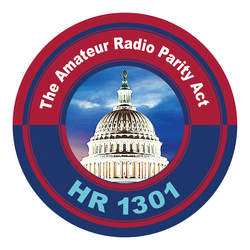 Lisenco had a special request of Florida radio amateurs. "Please write and call Sen.
Lisenco had a special request of Florida radio amateurs. "Please write and call Sen. 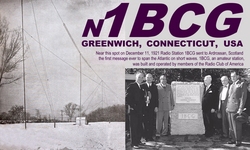 On December 11, 1921, reception in Ardrossan, Scotland, of a radio signal transmitted from the official test station of Minton Cronkhite, 1BCG, in a small shack on the corner of Clapboard Ridge Road and North Street in Greenwich, helped to usher in the age of global communication. The special event will use
On December 11, 1921, reception in Ardrossan, Scotland, of a radio signal transmitted from the official test station of Minton Cronkhite, 1BCG, in a small shack on the corner of Clapboard Ridge Road and North Street in Greenwich, helped to usher in the age of global communication. The special event will use 
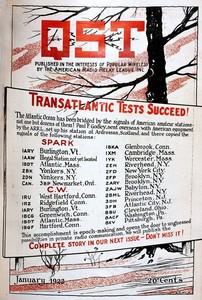
.png) "At this point, no additional Amateur Radio support has been requested," ARRL Tennessee Section Manager Keith Miller, N9DGK, said on Tuesday evening. "Members of nearby ARES® groups should remain aware of the potential for this situation to change rapidly."
"At this point, no additional Amateur Radio support has been requested," ARRL Tennessee Section Manager Keith Miller, N9DGK, said on Tuesday evening. "Members of nearby ARES® groups should remain aware of the potential for this situation to change rapidly."-1.jpg) TEMA said on November 30 that rain has provided some relief in Sevier County. "Gatlinburg reports all wildfires out, though some are still smoldering," TEMA said. Gatlinburg remains under a mandatory evacuation order and a 6 PM to 6 AM curfew remains in effect.
TEMA said on November 30 that rain has provided some relief in Sevier County. "Gatlinburg reports all wildfires out, though some are still smoldering," TEMA said. Gatlinburg remains under a mandatory evacuation order and a 6 PM to 6 AM curfew remains in effect..jpg) Sponsored by
Sponsored by 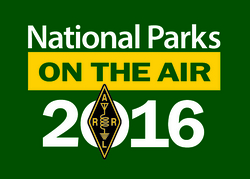 Seventeen activations are scheduled for the week of December 1-7, including Theodore Roosevelt Island National Memorial in Washington, DC, and Sitka National Historical Park in Alaska.
Seventeen activations are scheduled for the week of December 1-7, including Theodore Roosevelt Island National Memorial in Washington, DC, and Sitka National Historical Park in Alaska. 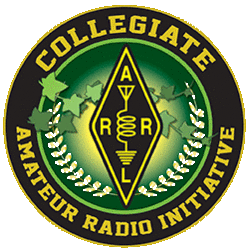 "The most common difficulty stems from uneven interest over time," said ARRL CEO Tom Gallagher, NY2RF, in his "Second Century" editorial, "Cheers for College Amateur Radio: Sis-boom-bah!" in the December 2016 issue of QST. "Even the strongest leaders in college Amateur Radio graduate every 4 years, sometimes leaving their clubs without adequate continuity or leadership succession."
"The most common difficulty stems from uneven interest over time," said ARRL CEO Tom Gallagher, NY2RF, in his "Second Century" editorial, "Cheers for College Amateur Radio: Sis-boom-bah!" in the December 2016 issue of QST. "Even the strongest leaders in college Amateur Radio graduate every 4 years, sometimes leaving their clubs without adequate continuity or leadership succession."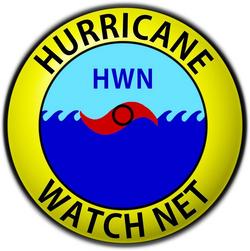 "All members of HWN gave their best effort to obtain weather data from the affected areas of Nicaragua and Costa Rica," said Net Manager Bobby Graves, KB5HAV. He said that, with poor propagation on both 20 and 40 meters, the only station in the affected region the HWN was able to contact was in Costa Rica. Graves said that during the off-season, he would reach out to all hurricane-prone countries in the Atlantic Basin, to encourage their radio amateurs to participate in the net during hurricane emergencies.
"All members of HWN gave their best effort to obtain weather data from the affected areas of Nicaragua and Costa Rica," said Net Manager Bobby Graves, KB5HAV. He said that, with poor propagation on both 20 and 40 meters, the only station in the affected region the HWN was able to contact was in Costa Rica. Graves said that during the off-season, he would reach out to all hurricane-prone countries in the Atlantic Basin, to encourage their radio amateurs to participate in the net during hurricane emergencies.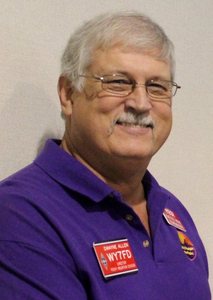

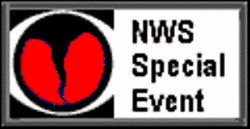 Developed by ARRL and the National Weather Service (NWS) in 1999, SKYWARN Recognition Day honors the contributions that SKYWARN volunteers make to the NWS mission -- the protection of life and property during threatening weather. During the SKYWARN Special Event, hams will operate from several NWS offices. W1AW will take part in the event. So will
Developed by ARRL and the National Weather Service (NWS) in 1999, SKYWARN Recognition Day honors the contributions that SKYWARN volunteers make to the NWS mission -- the protection of life and property during threatening weather. During the SKYWARN Special Event, hams will operate from several NWS offices. W1AW will take part in the event. So will 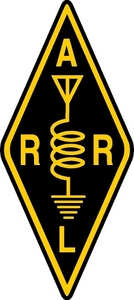 The Hiram Percy Maxim Award recognizes a radio amateur and ARRL member under age 21, whose accomplishments and contributions are of the most exemplary nature within the framework of Amateur Radio activities. Nominations for this award need to be made through your ARRL Section Manager, who will then forward the nomination to ARRL Headquarters by March 31, 2017.
The Hiram Percy Maxim Award recognizes a radio amateur and ARRL member under age 21, whose accomplishments and contributions are of the most exemplary nature within the framework of Amateur Radio activities. Nominations for this award need to be made through your ARRL Section Manager, who will then forward the nomination to ARRL Headquarters by March 31, 2017. "The Hamvention Awards event has been held since 1955," a Hamvention news release said. "Over these years, many amateurs have been honored for their dedication and selfless contributions to our avocation and to mankind." Nominees are invited for these awards.
"The Hamvention Awards event has been held since 1955," a Hamvention news release said. "Over these years, many amateurs have been honored for their dedication and selfless contributions to our avocation and to mankind." Nominees are invited for these awards. JOTA 2016 Report Shows Participation was Up: The Boy Scouts of America has released the
JOTA 2016 Report Shows Participation was Up: The Boy Scouts of America has released the 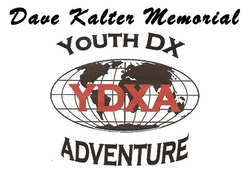 Dave Kalter Youth DX Adventure Offering Complete Ham Station to Essay Contest Winner: The Dave Kalter Youth DX Adventure (YDXA) has announced an exciting
Dave Kalter Youth DX Adventure Offering Complete Ham Station to Essay Contest Winner: The Dave Kalter Youth DX Adventure (YDXA) has announced an exciting  NCVEC Question Pool Committee Seeks Comments on the Technician Question Pool: The National Conference of Volunteer Examiner Coordinators (
NCVEC Question Pool Committee Seeks Comments on the Technician Question Pool: The National Conference of Volunteer Examiner Coordinators (
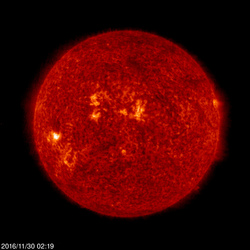 Predicted solar flux is 85 on December 1-3; 80 on December 4-8; 78 on December 9-11; 80 on December 12-13; 82 on December 14-15; 80 on December 16-17; 78 on December 18-19; 80 on December 20-22; 82 on December 23-24; 84 on December 25; 83 on December 26-27; 80 on December 28-29; 82 on December 30-31; 80 on January 1-2; 78 on January 3-7, and 80 on January 8-9.
Predicted solar flux is 85 on December 1-3; 80 on December 4-8; 78 on December 9-11; 80 on December 12-13; 82 on December 14-15; 80 on December 16-17; 78 on December 18-19; 80 on December 20-22; 82 on December 23-24; 84 on December 25; 83 on December 26-27; 80 on December 28-29; 82 on December 30-31; 80 on January 1-2; 78 on January 3-7, and 80 on January 8-9.







